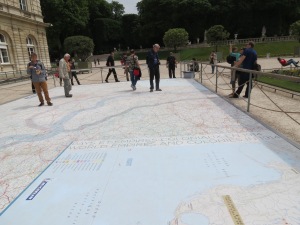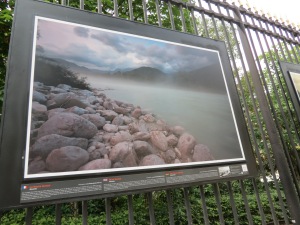In Paris at the Luxembourg Gardens was a fascinating free exhibition, called Fields of Battle—Terres de Paix 14-18, an Anglo-French collaboration (April 4-August 4, 2014).
It was in 2 parts: large photo panels and a huge map mounted onto the ground. The photographer is Michael St Maur Sheil.
Many large photos were posted along the outside garden railings (where they often have picture exhibitions), each with French, English and German explanations. Each panel links past and present, with small black and white photos from WW1 times, or short poems of stories of people. It’s been developed as a gateway to the battlefields and is a different way for people to find out more about WW1. It tries to reveal some of the landscapes of battle and illustrate the stories of some of the people who experienced those battles.
The sub-title of the photographic exhibit is “Forests have a history to share”. The focus was on forests and trees during WW1 and showcases iconic forest battlefield sites, such as Verdun. It’s based, not just on the horrors of war, but on how over time nature has (mostly) healed the battlefields, trenches and other landscapes, creating a link between the modern day and the personal dramas and stories these peaceful landscapes now hide.
All the photos are incredible and thought-provoking, but here are 5 that seemed especially interesting to us, providing information we’d not known before.
First, Corkscrew Picket, Flanders, Belgium. Originally invented in the USA in the late 1880s to keep animals in place, barbed wire became the most common form of obstacle against infantry and was used by all sides in the war. Making this obstacle on the battlefield was dangerous because of the noise of hammering the metal pickets into the ground. In 1915 the Germans invented a metal stake with a corkscrew at the end that could be turned silently to anchor into the ground. Millions were manufactured and farmers still use them today. The tip gave them their name, the “Tir de cochon” or “pig’s tail”.
 Second, Marshes of the River Ancre, Authuille, Somme area. The war-torn landscapes of 1914-18 affected a whole generation of writers, poets, musicians and artists, who left us their haunted memories, including Tolkien. Lieutenant J. R. R. Tolkien was one of thousands of British soldiers crouching in trenches when the battle of the Somme began here on July 1, 1916. The eerie landscape amidst the marshes of the River Ancre was one of the stimuli for his novel “Lord of the Rings”.
Second, Marshes of the River Ancre, Authuille, Somme area. The war-torn landscapes of 1914-18 affected a whole generation of writers, poets, musicians and artists, who left us their haunted memories, including Tolkien. Lieutenant J. R. R. Tolkien was one of thousands of British soldiers crouching in trenches when the battle of the Somme began here on July 1, 1916. The eerie landscape amidst the marshes of the River Ancre was one of the stimuli for his novel “Lord of the Rings”.
Third, Battlefield Burial Site Memorial, Marne. This stark image of a helmet shows how most soldiers’ burials were initially marked on the western front. Later, after the fighting, lone graves, like this one of a French soldier, were moved into national war cemeteries with wooden crosses as grave markers. Later, Germany, France, Belgium, Britain and the USA established war graves commissions to design permanent graveyards, with stone or concrete markers for each soldier, and memorial panels for the missing. Sadly, many hundreds of thousands of soldiers are still unaccounted for. Nearly every lone grave has been transferred to a war cemetery, except this one, now hidden away on private land.
 Next, the Trenches at Beaumont-Hamel, Somme. As part of this war, sides dug in: the trenches that scarred the landscape became one of the ghastly icons of the 20th century.
Next, the Trenches at Beaumont-Hamel, Somme. As part of this war, sides dug in: the trenches that scarred the landscape became one of the ghastly icons of the 20th century.
Lastly, River Izonzo in Slovenia. The now peaceful River Izonzo, called Soca in Slovenia, was the scene of 12 attritional battles between the Italians and the Austro-Hungarian Empire during 1915-18. These campaigns cost both sides over 300,000 lives, literally making the river run like blood. Many people don’t realize that WW1 was not only fought on the Western Front.
We like photography as a medium and found this a very clever and intellectual way of linking modern photos to a hugely significant event 100 years ago, one that changed the whole world. The modern photos capture the unique beauty of the landscape, in a healing sort of way, as Nature slowly covers up some of the stark scars. It was also neat to learn the origin of some words, like schrapnel and land mines.
The other significant and very informative feature of this exhibition was a giant map mounted onto the ground. Michelin (of map fame since 1889) created a map of the battlefields, memorial sites and countries involved in the conflict. It was in front of the Palais du Luxembourg (now the French Senate). This giant map—16x8m with surrounding information panels— combines geographical, historical and tourism information, which complements the exhibition. People are encouraged to walk on the map, which gives a really visceral understanding of where the conflict was. As we walk between the countries in Europe, it highlights the scale and complexity of the conflict with details of key battlefield locations. What is most amazing is to see and walk on the line depicting the Front Line, the front that didn’t move that much, in France or Belgium. It moved only a very little, for very little gain, great loss of life and terrible loss of resources. In that sense, the map captured how futile WW1 was—in the sense of losing lives and not gaining much actual ground.
The handrail around the giant map is made from a hundred-year-old beech tree that survived the Battle of Charmes, which took place early in the war. It is a symbol that connects the history of the ravaged forests with events today.
On August 4, 2014 this exhibition moved to London and is being exhibited in St James’s Park as Fields of Battle, Lands of Peace 14-18 until November 11th. It’s a free street gallery project to reach audiences who might normally not visit a museum or art gallery and to give them a chance to see the battlefields as they are today. After that, it will tour the UK and internationally until 2018, as a way of bringing the Centenary to hundreds of thousands of people.











